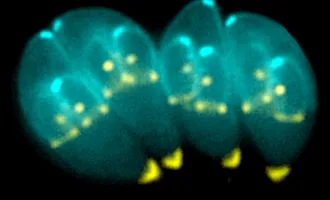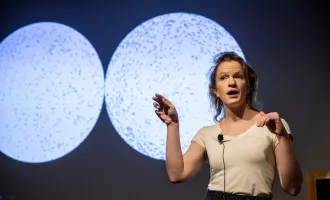Journal Club: Biochemistry, Chemical Biology, Developmental Biology, and Neuroscience
BIOCHEMISTRY: A pause sequence enriched at translation start sites drives transcription dynamics in vivo. Larson, M.H., et al. (Weissman). Science. 2014 May 1. Epub ahead of print.
In high school biology class, RNA transcription is usually depicted as a smooth process of polymerase binding followed by steady transcription of the whole gene. In fact, transcription proceeds fitfully, with a number of pauses playing regulatory roles.
Thus far, only a small number of pause sites have been identified, and even these are largely products of in vitro studies. In this publication, Larson and colleagues report the results of in vivo study of transcription in E. coli in which they captured and sequenced RNA in the midst of being transcribed.
They identified a 16-nucleotide-long sequence found at thousands of pause sites as well as translation start sites. They further used in vitro studies to find that interaction between this sequence and the RNA polymerase interfered with the addition of another nucleotide, resulting in pausing.
CHEMICAL BIOLOGY: A crosslinker based on a tethered electrophile for mapping kinase-substrate networks. Riel-Mehan, M.M. and Shokat, Chem Biol. 2014 Apr 15. Epub ahead of print.
The kinases are an abundant family of enzymes that transfer phospate groups from molecules such as ATP. Although many kinase-substrate pairs have been delineated, there are still many sites of phosphorylation for which the responsible kinase is unknown. Moreover, it remains easier to determine the targets of a given kinase than the reverse.
In this article, Riel-Mehan and Shokat first evaluated a dialdehyde-based tagging probe designed to mimic a particular substrate and then become crosslinked to the enzyme attempting to phosphorylate it. Although this probe worked to some degree, it did not crosslink efficiently enough to permit unbiased kinase identification.
They then developed and characterized an alternative ATP-biotin-based probe that proved more efficient and therefore more promising as a means for better characterizing these kinase-substrate pairs.
DEVELOPMENTAL BIOLOGY: Identification of Hipk2 as an essential regulator of white fat development. Sjӧland, J. et al. (Balmain). PNAS. 2014 Apr 30. Epub ahead of print.
A reductionist approach has been responsible for much of the immense gains in biological understanding in the past two centuries. With greater observational and informatics capabilities, however, an alternative system-based approach has also become increasingly pragmatic. This trend is well demonstrated by this paper, in which the authors wedded both approaches to come to a better understanding of the transcription factor Hipk2.
They began by examining gene expression in the skin and mammary gland of a set of geneticially heterogenous mice, identifying genes whose expression correlated well with that of Hipk2. They noted many of these coexpressed genes were already known to be important in adipocytes—fat cells.
They further found that genetic deletion of Hipk2 led to less white fat. These mice also have increased insulin sensitivity and reduced weight gain when fed a high fat diet, suggesting that Hipk2 may be a useful therapeutic target.
NEUROSCIENCE: Astrocyte-encoded positional cues maintain sensorimotor circuit integrity. Molofsky, A.V., et al. (Rowitch). Nature. 2014 Apr 28. Epub ahead of print.
A functional nervous system requires the precise and coordinated projection of axons thousands of times longer than the cell body from which they emanate. Yet while neurons get all the fame, the true stars may be the astrocytes—critical support cells that outnumber neurons.
Astrocytes have already been known to play important roles in synapse formation and to develop in a regionally restricted fashion, but the functional differences between these different regions of astrocytes remained unclear.
In this paper, Molofsky and colleagues results primarily concerned the ventral spinal cord. They found that loss of semaphorin 3a in astrocytes led to loss of correct orientation and death of alpha motor neurons. They also demonstrated a role for these astrocytes in supporting normal axon development of a subset of sensory neurons.


